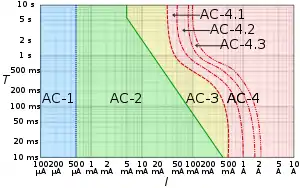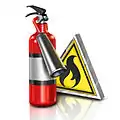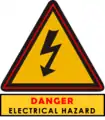Electrical safety is a system of organizational measures and technical means to prevent harmful and dangerous effects on workers from electric current, arcing, electromagnetic fields and static electricity.
History
The electrical safety develops with the technical progress. In 1989 OSHA[1] promulgated a much-needed regulation in the General Industry Regulations. Several standards are defined for control of hazardous energy, or lockout/tagout. In 1995 OSHA was successful in promulgation of regulations for utility.[2] In 1994 were established Electrical Safety Foundation International non-profit organization dedicated exclusively to promoting electrical safety at home and in the workplace.[3]
- Standard 29 CFR 1910.269 – for electric power generation, transmission, and distribution, contained comprehensive regulations and addressed control of hazardous energy sources for power plant locations
Standards are compared with those of IEEE and National Fire Protection Association.[4]
Lightning and earthing protection
Lightning and Earthing protection systems are essential for the protection of humans, structures, protecting buildings from mechanical destruction caused by lightning effects and the associated risk of fire, Transmission lines, and electrical equipment from electric shock and Overcurrent.[5]
Earthing protection systems

- TT system
- TN system
- IT system[6]
Lightning protection systems
- lightning rod (simple rod or with triggering system)
- lightning rod with taut wires.
- lightning conductor with meshed cage (Faraday cage)
Physiological effects of electricity
Electrical shocks on humans can lead to permanent disabilities or death. Size, frequency and duration of the electrical current affect the damage.[7] The effects from electric shock can be: stopping the heart beating properly, preventing the person from breathing, causing muscle spasms. The skin features also affect the consequences of electric shock.[8]

- Indirect contact – can be avoided by automatic disconnection for TT system, automatic disconnection for TN systems, automatic disconnection on a second fault in an IT system, measures of protection against direct or indirect contact without automatic disconnection of supply
- Direct contact – can be avoided by protection by the insulation of live parts, protection by means of barriers or enclosures, partial measures of protection, particular measures of protection[9]
Electrical safety conductors
 United States (USA) NEC 2008 Table 250.122 – Safeco Electric Supply
United States (USA) NEC 2008 Table 250.122 – Safeco Electric Supply
Electrical safety standards
 Australia (AUS) Australian Standards – Australia – AS/NZS 3000:2007, AS/NZS 3012:2010, AS/NZS 3017:2007, AS/NZS 3760:2010, AS/NZS 4836:2011[10]
Australia (AUS) Australian Standards – Australia – AS/NZS 3000:2007, AS/NZS 3012:2010, AS/NZS 3017:2007, AS/NZS 3760:2010, AS/NZS 4836:2011[10] Bulgaria (BUL) Български Държавен Стандарт – (On English:Bulgarian state standard) – БДС 12.2.096:1986 Bulgaria[11]
Bulgaria (BUL) Български Държавен Стандарт – (On English:Bulgarian state standard) – БДС 12.2.096:1986 Bulgaria[11] Brazil (BRA) Brazilian National Regulation – NR10 Brazil[12]
Brazil (BRA) Brazilian National Regulation – NR10 Brazil[12] China (CHN) – China GB4943, GB17625, GB9254[13]
China (CHN) – China GB4943, GB17625, GB9254[13] Germany (GER) IEEE/TÜV – Germany NSR Niederspannungsrichtlinie 2014/35/EU [14]
Germany (GER) IEEE/TÜV – Germany NSR Niederspannungsrichtlinie 2014/35/EU [14] France (FRA) La norme français C 15-100 – Aspects de la norme d’installation électrique France[15]
France (FRA) La norme français C 15-100 – Aspects de la norme d’installation électrique France[15] Great Britain (GBR) British standard – United Kingdom[16] BS EN 61439, BS 5266, BS 5839, BS 6423, BS 6626, BS EN 62305, BS EN 60529
Great Britain (GBR) British standard – United Kingdom[16] BS EN 61439, BS 5266, BS 5839, BS 6423, BS 6626, BS EN 62305, BS EN 60529 India (IND) India Standardization – India – IS-5216, IS-5571, IS-6665[17]
India (IND) India Standardization – India – IS-5216, IS-5571, IS-6665[17] Poland (POL) Polska Norma – Poland – PN-EN 61010-2-201:2013-12E[18]
Poland (POL) Polska Norma – Poland – PN-EN 61010-2-201:2013-12E[18] Russia (RUS) – ГОСТ 12.2.007.0-75,ГОСТ Р МЭК 61140-2000,ГОСТ 12.2.007.0-75,ГОСТ Р 52726-2007 Russia|[19]
Russia (RUS) – ГОСТ 12.2.007.0-75,ГОСТ Р МЭК 61140-2000,ГОСТ 12.2.007.0-75,ГОСТ Р 52726-2007 Russia|[19] United States (USA) NFPA, IEEE STD 80, IEEE STD 80 – United States[20]
United States (USA) NFPA, IEEE STD 80, IEEE STD 80 – United States[20]
NFPA 496, NFPA 70
 Netherlands (NED) NEN 1010
Netherlands (NED) NEN 1010
Lightning protection standards
 United States (USA) NFPA 780, IEC 62305
United States (USA) NFPA 780, IEC 62305 Russia (RUS) СТО 083-004-2010,ГОСТ Р МЭК 62561.2-2014
Russia (RUS) СТО 083-004-2010,ГОСТ Р МЭК 62561.2-2014 Bulgaria (BUL) БДС EN 62305-1:2011
Bulgaria (BUL) БДС EN 62305-1:2011 France (FRA) Norme NF C 15-100
France (FRA) Norme NF C 15-100 Germany (GER) DIN EN 62305-1
Germany (GER) DIN EN 62305-1 Poland (POL) PN-EN 62305
Poland (POL) PN-EN 62305 Great Britain (GBR) BS-EN 62305
Great Britain (GBR) BS-EN 62305 Spain (ESP) UNE 21186. Protección contra el rayo
Spain (ESP) UNE 21186. Protección contra el rayo Indonesia (INA) SNI 03-7015-2004
Indonesia (INA) SNI 03-7015-2004 India (IND) IS 2309
India (IND) IS 2309 China (CHN) GB/T 36490-2018
China (CHN) GB/T 36490-2018
Electronics and communications
Electronic products safety standards
The manufacturers of electronic tools must take into account several standard for electronic safety to protect the health of humans and animals.
- ANSI C95.3:1972 – Techniques & instrumentation for measurement of
potentially hazardous electromagnetic radiation at microwave frequencies.[21]
Communication and high frequency safety standards
Few standard were introduced for the harmful impact from high frequency,![]() Canada (CAN) CB-02 Radio Equipment[23]
Canada (CAN) CB-02 Radio Equipment[23]
- ANSI/IEEE 1.2 mW/Cm for antennas 1800-2000 MHz range.[24]
- Radio Communication safety
 United States (USA) ANSI/IEEE C95.1-1992,[25]
United States (USA) ANSI/IEEE C95.1-1992,[25] Russia (RUS) ГОСТ Р 50829-95
Russia (RUS) ГОСТ Р 50829-95 - Mobile Communication safety 73/23/EEC and 91/263/EEC[26]
See also
Gallery
 Danger symbol
Danger symbol Principle Protection separation
Principle Protection separation Safe distances earthing
Safe distances earthing Lightning rod
Lightning rod Extra low voltage symbol
Extra low voltage symbol Fire protection symbol
Fire protection symbol Electrical Hazard symbol
Electrical Hazard symbol
References
- ↑ Controlling electrical hazard
- ↑ Brainfilter.com
- ↑ ESFI
- ↑ The history of electrical safety
- ↑ http://www.electrical-knowhow.com
- ↑ Electrical installations
- ↑ Physiological Effects of Electricity
- ↑ Electrical injuries
- ↑ electrical-installation.org
- ↑ Australian Electrical Standards
- ↑ BDS Official webpage
- ↑ Brazilian National Standard Page
- ↑ CCC Certification
- ↑ https://www.tuev-nord.de
- ↑ http://www.france-electric.com
- ↑ British standard
- ↑ Indian standard
- ↑ Bezpieczenstwo-uzytkowania-i-funkcjonalne
- ↑ НАЦИОНАЛЬНЫЙ СТАНДАРТ РОССИЙСКОЙ ФЕДЕРАЦИИ Система стандартов безопасности труда
- ↑ https://www.osha.gov
- ↑ "Electronic products safety standards" (PDF). Archived from the original (PDF) on 2018-05-16. Retrieved 2017-06-28.
- ↑ http://www.metlabs.com
- ↑ http://www.metlabs.com
- ↑ High Frequency Radiation and Human Exposure Mahmoud M. Dawoud
- ↑ Radio frequency safety standards
- ↑ ГОСТ
- Дулицкий Г. А., Комаревцев А. П. Электробезопасность при эксплуатации электроустановок напряжением до 1000 В. Справочник. — М.: Воениздат, 1988.
- IEC 60050-195:1998. International Electrotechnical Vocabulary. Part 195: Earthing and protection against electric shock. Edition 1.0. – Geneva: IEC, 1998‑08.
- Marinela Yordanova – Technical Safety, Bulgaria BDS standards, 2010
- M.M. Dawoud, A.S. Farag, J.M. Bakhashwain, and A. Frazi,"Study of EM Fields and
Radiated Power Generated from Dammam Radio Stations,"1998
- N. Kuster, Q. Balzano, James C. Lin – Mobile Communications Safety, Springer Science & Business Media, 6 Dec 2012